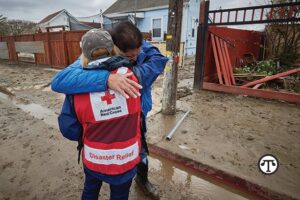Health, Home & Family
 (NAPSI)—When it comes to combating polio, there’s good news, bad news and better news.
(NAPSI)—When it comes to combating polio, there’s good news, bad news and better news.
The good news is that efforts to eradicate the dreaded disease have been going on for decades. Back in the disease’s peak years in the 1940s and 50s, it affected between 13,000 and 20,000 people in the United States each year, many of them children. Thousands died. Many others were permanently paralyzed. Then Jonas Salk and Albert Sabin developed vaccines and the number of cases dropped. As of August 30, 2023, only seven cases of “wild polio virus” (two in Pakistan, five in Afghanistan) have been detected in 2023.
The bad news is that even one case of polio is one too many, and while cases of polio have fallen over 99% worldwide since 1988, a variant of the polio virus is causing outbreaks and consuming critical resources needed to stop the transmission of wild poliovirus. What’s more, the COVID-19 pandemic disrupted efforts to combat vaccine-preventable diseases, including polio. Continue reading
New Tools Help Teachers Improve Student Literacy
The Problem
The National Assessment of Educational Progress, an organization that measures academic performance of students from across the country, has long term data that shows 9-year-old students scored, on average, five points lower in reading in 2022 than did their pre-pandemic peers in 2020. The declines represent the largest drops in decades.
Fortunately, educators don’t have to combat this issue alone. As part of the Discover Literacy education program, the Dollar General Literacy Foundation, National Afterschool Association and Discovery Education created five short, animated videos to help teachers and other school professionals master best practices for literacy instruction. Continue reading
Mission BBQ (stylized as MISSION BBQ) is an American barbecue restaurant chain based in Glen Burnie, Maryland. Bill Kraus and Steve Newton opened the first location on September 11, 2011, as a way to support the military, police, firefighters, and first responders.
I must have been a sleep at the wheel. I have never been to Mission BBQ. When I try to tell people about my new experience at Mission BBQ they they have already been there. I thought it was a best kept secret. It was not! I had the best brisket on a bun than I have had in years. You could get it wet or lean. The wet had some marbling and was very moist and tender, I will do that again. I will go online and see what else they have to offer but the people were friendly, the service was out of sight and the food was over the wall.
 (NAPSI)—There may be a problem lurking in your house that you can’t even see: dirty ducts. But that doesn’t have to be.
(NAPSI)—There may be a problem lurking in your house that you can’t even see: dirty ducts. But that doesn’t have to be.
The Issue
Even with the proper use of filters, your home’s heating and cooling system gets really dirty through normal, everyday use, just as surfaces in your home get dusty over time.
All sorts of contaminants and air pollutants—bacteria, pet dander, dust, skin cells, mold, tobacco smoke, even chemicals—get pulled into an HVAC system and recirculate through the home several times a day, building up in the system.
Worse, rodents and insects can chew their way into the ductwork to travel throughout your home, build nests and leave droppings. Telltale signs include chewed materials, unpleasant smells, and bacteria contaminating the air you breathe. Continue reading
(NAPSI)—Here’s news to help you breathe easier: Although respiratory virus season is upon us, you can protect yourself and your loved ones. How? Make sure you’re up to date on all of your vaccinations. Following vaccination, it takes time for your body to build protection against the flu, COVID-19 and RSV, so it’s recommended that you get the vaccines you’re eligible for as soon as possible to support your health and the health of your community.
Vaccinations help prevent the flu, COVID-19 and RSV
Getting a flu shot is the best way to protect yourself and your family from the flu. The Centers for Disease Control and Prevention (CDC) recommends getting vaccinated early in the fall, before flu season begins, ideally before the end of October. It’s especially important to protect at-risk populations—adults 65 and older, those with certain immunocompromising or chronic medical conditions, infants or children under 5 and pregnant women—from severe illness. Continue reading

March 23, 2023. Pajaro, California. Gustavo Baez, Pajaro, California homeowner, hugs American Red Cross volunteer, Cindy Huge. and thanks, her, and the many volunteers for caring about his community. Photo by Jaka Vinsek/American Red Cross
(NAPSI)—Families across the country cope with the effects of the climate crisis as extreme storms, wildfires, heat and floods grow in frequency and intensity. In fact, one of the nation’s leaders in disaster relief, the American Red Cross, now responds to nearly twice as many large disasters across the country as it did a decade ago.
National Preparedness Month in September is an important reminder to help your family and pets stay safe by taking action now with three simple steps: Get a kit, make a plan and be informed.
Get a Kit
Build your emergency kit with a gallon of water per person, per day; non-perishable food; a flashlight; and a battery-powered radio. Also include a first aid kit, medications, supplies for infants or pets, a multi-purpose tool and personal hygiene items. Don’t forget to add copies of important papers, cell phone chargers, blankets, maps of the area and emergency contact information. Continue reading

Cooking, girl or women bond helping with milk in dessert, breakfast food or sweet recipe in house or family home kitchen. Happy, smile or baking parent, senior grandmother or learning Brazilian child
(NAPSI)—Hispanic Heritage Month, September 15 through October 15, celebrates legacies from past generations. In many Latino cultures, that includes lessons mothers share with their children on taking care of the home and family. That’s one reason this month (and all through the year), many people like to recognize mothers and the Hispanic-owned brands that are dedicated to helping them keep a wonderfully clean home.
For example, AlEn USA is the North American subsidiary of one of the most recognized companies in the household cleaning products category in Mexico: Industrias AlEn S.A de C.V (Grupo AlEn). Since its beginning in 1949, Grupo AlEn has pioneered well-known consumer brands popular in Mexico.
For many Hispanic moms, fragrance is a top priority when it comes to a clean home. They feel nothing says “te amo” like soft, fresh smelling laundry, and Ensueño Max fabric softener will ensure that everything from socks to sweatshirts has a long-lasting scent and that your fabrics stay soft and wear well.
One product many Hispanic families have in their cleaning cabinet is Pinalen Original, a pine oil-based cleaner that degreases, fights stains, shines floors, and more. Not only does Pinalen Original have the highest percentage of pine oil compared to any other pine-based cleaner on the market, the manufacturer harvests the pine oil from a sustainable, company-owned plantation in Mexico.
As for the well-loved surfaces in Mom’s home that could use some elbow grease, there’s Cloralen Multipurpose Cleaner. It eliminates stains and grease in even such tough-to-clean spots as bathroom tile, kitchen counters, toilet tanks and more.
Then your mother and entire family can enjoy a clean kitchen in which to cook and share a festive meal.
(NAPSI)—If any of the approximately 74 million schoolchildren in the U.S. is someone you care about, here’s something you may want to look into: According to the National Institutes of Health (NIH), visual health can have a great influence on students’ academic performance. Visual disorders, the NIH says, are one of the best predictors of educational success.
A Look Into The Eye
The eye is literally an extension of the brain. It is estimated that more than 60% of the brain has some duties associated with vision input, the American Optometric Association points out. Because of this, any condition that hampers vision or the processing of vision may result in learning problems. When diagnosed and treated early, however, most individuals have a better chance of learning efficiently. Continue reading
FARMS is an agricultural cost-share reimbursement program that reduces groundwater withdrawals from the Upper Floridan aquifer through conservation and alternative water supply best management practices (BMPs). In conjunction with water conservation BMPs, water quality and natural systems improvement BMPs also may be cost-shared in priority areas.
The program is designed to serve as an incentive to the agricultural community to promote water quantity, water quality and natural systems BMPs to conserve groundwater use and promote resource sustainability.
Examples of commonly used BMPs include:
- Weather stations and soil moisture sensors with telemetry
- Riser culverts and water-controlled structures
- Surface water or tailwater irrigation pumps and filters
- Remote irrigation zone controls and soil moisture and climate sensor telemetry
- Fertigation systems
- Cold protection measures
FARMS is a public/private partnership developed by the District and the Florida Department of Agriculture and Consumer Services.
Program Goals
The FARMS Program focuses on Upper Floridan aquifer withdrawal savings throughout the District as well as water quality and natural systems improvements in targeted Water Use Caution Areas and priority watersheds.
- Improve water quality within the Shell, Prairie and Joshua Creek (SPJC) Watersheds
As of July 2023, the 87 Board-approved projects located within the SPJC watershed are projected to offset approximately 11.9 million gallons per day (mgd) of groundwater through BMP implementation. An additional water resource benefit is reductions in the potential for groundwater mineralization of surface waters while improving water quality in the City of Punta Gorda’s drinking water reservoir. Prairie Creek has been removed from the list of impaired waterbodies by the Department of Environmental Protection, indicating the success of the program. - Improve natural systems in the Upper Myakka River Watershed (UMRW)
As of July 2023, nine projects have been approved and are operational offsetting 2.8 mgd through conservation and the reuse of tailwater. These projects are reducing the contribution of groundwater to this volume-sensitive basin. - Reduce groundwater use by 40 mgd within the Southern Water Use Caution Area (SWUCA)
As of July 2023, 195 projects have been approved with 174 operational projects having offset 22.4 mgd. These projects are reducing the amount of groundwater pumped from the Upper Floridan Aquifer. - Reduce groundwater use within the Most Impacted Area (MIA)
The MIA is an area specifically affected by groundwater withdrawals within the SWUCA. It’s about 700 square miles and located along the southern Hillsborough, Manatee and northwestern Sarasota counties. As of July 2023, 18 projects have been approved with 18 operational projects having offset 3.4 mgd. - Reduce groundwater use within the Central Florida Water Initiative (CFWI) region
Although not fully incorporated within the SWUCA, the CFWI has been identified as a priority area in which the implementation of agricultural BMPs to reduce Upper Floridan groundwater use will help to ensure future water needs are met. As of July 2023, 27 projects have been approved with 24 operational projects having offset 1.5 mgd. - Reduce cold protection groundwater use within the Dover/Plant City Water Use Caution Area (DPCWUCA)
The DPCWUCA was established in 2011 as a result of an extended freeze event in 2010 that resulted in numerous dry well complaints and sinkholes due to agricultural-related groundwater pumping for cold protection. As of March 2023, 24 projects have been approved with 21 operational projects having offset 72.4 million gallons per freeze event. - Implement agricultural BMPs to reduce groundwater use and reduce nutrient loading
As of July 2023, 15 operational projects having offset 0.7 mgd and reducing nutrient loading by approximately 5,182 pounds per year.
The approved projects support the District’s Regional Water Supply Plan, SWUCA Recovery Strategy, Strategic Plan and the Springs Management Plans.
Program Funding Qualifications
To qualify for funding, projects must be located in the District and include one or more of the following BMP strategies:
- Utilize an alternative water supply or technology to reduce groundwater use.
- Improve irrigation water quality and watershed ecology by reducing reliance on poorer quality groundwater.
Project Guidelines
- Growers manage their projects and are reimbursed for approved expenses.
- Reimbursement can amount to as much as 75 percent of total project costs with water quality and groundwater quantity savings / conservation BMPs; and as much as 50 percent with water quality or groundwater quantity savings / conservation BMPs.
- District and grower(s) enter into a signed and executed contractual agreement for the FARMS project with a contract duration generally 5–10 years.
- Growers are responsible for obtaining all project-related permits and must have District authorization prior to incurring approved reimbursable expenses.
- Permitted water use allocations are not reduced. Southwest Florida Water Management
Find out more at https://www.swfwmd.state.fl.us/
 (NAPSI)—Lady Gaga has been living with a silent disease—migraine—for most of her life, having been diagnosed when she was 14 years old. Her migraine attacks were so severe, she was often bedridden for days. She couldn’t read or keep lights on and would have to be alone in a quiet room for hours, or sometimes even days, until the pain subsided. Lady Gaga continued to experience migraine attacks into adulthood and the disease has impacted all aspects of her life.
(NAPSI)—Lady Gaga has been living with a silent disease—migraine—for most of her life, having been diagnosed when she was 14 years old. Her migraine attacks were so severe, she was often bedridden for days. She couldn’t read or keep lights on and would have to be alone in a quiet room for hours, or sometimes even days, until the pain subsided. Lady Gaga continued to experience migraine attacks into adulthood and the disease has impacted all aspects of her life.
“By the time I was 25, I was dealing with other medical conditions along with my migraine. The combination of pain from migraines and managing these other conditions had become so difficult that I was barely functional. And the migraines were now much more present. The hardest part about dealing with this change in my life is that it was now not once a month that I was getting migraines, but much more frequently.” Continue reading
